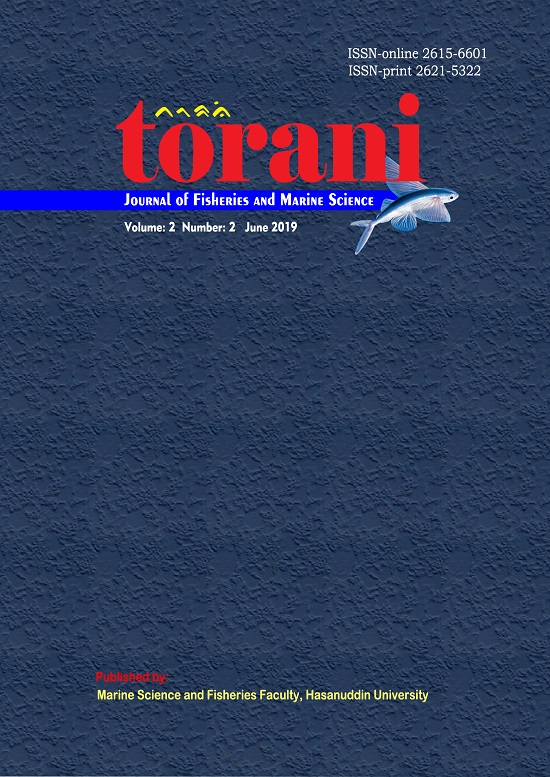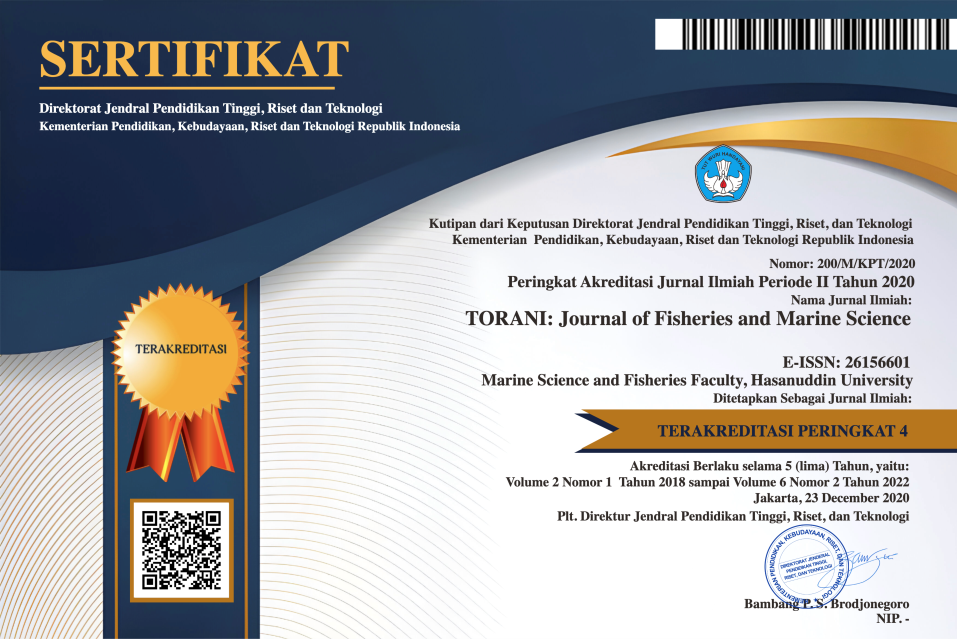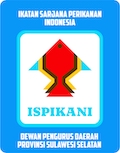Use of Probiotics to Fight Bacterial Populations of Vibrio sp. on Vaname Shrimp Cultivation (Litopenaeus vannamei)
DOI:
https://doi.org/10.35911/torani.v2i2.7056Abstract
The consequence of super intensive shrimp farming is an increase in aquaculture waste and disease transmission. Vibrio sp. Bacteria is a disease-causing agent in shrimp larvae when the shrimp is in a state of stress and weakness, and can cause death. The application of probiotics, namely beneficial microorganisms can degrade organic matter, reduce disease, and help accelerate the process of nutrient cycles as a consequence of super intensive shrimp farming. Commercial probiotics currently available are a mixture of several types of beneficial microorganisms, namely Bacillus sp., Pseudomonas sp., Nitrosomonas sp., Aerobacter sp., and Nitrobacter sp. The purpose of this study was to evaluate the use of probiotics with different time intervals to produce a decrease in the population of Vibrio sp. The research method applied was the treatment of commercial probiotics at different intervals of three, five, and seven days and without the administration of probiotics as controls. Furthermore, the bacterial population was calculated by total plate count (TPC). The results showed that the administration of probiotics had a significant effect on the decrease in the population of Vibrio sp. Provision of probiotics three days apart showed a decrease in the number of bacterial populations that were significantly different from the controls, but the same as the administration of intervals of five and seven days. The decrease in the number of bacterial populations in the treatment interval of three, five, and seven days in a row is 0.05 x , 0.41 x , and 0.61 x CFU / ml. This study recommends that the use of commercial probiotics intervals of seven days for super intensive vaname shrimp farming. The use of probiotics for three days indicates an impact on the increase in expenditure costs for probiotics. Commercial probiotic studies modified with natural microorganisms are thought to be able to streamline the operational costs of shrimp farming.
Keywords: Vibrio sp. bacteria, probiotics, vaname shrimp, super intensive cultivation
References
Arief, M., N. Fitriani dan S. Subekti. 2014. Pengaruh Pemberian Probiotik Berbeda Pada Pakan Komersial Terhadap Pertumbuhan dan Efi- siensi Pakan Ikan Lele Sanglariang (Clarias sp.). Jurnal Ilmiah Perikanan dan Kelautan 6(1) : 49 - 52.
Burhanuddin, Wahyu, F., & Suratman. (2016). Aplikasi Probiotik Dengan Kosentrasi Yang Berbeda Terhadap Pertumbuhan Udang Vannamei (Litopenaeus Vannamei). OCTOPUS Jurnal Ilmu Perikanan, 5(1), 462–465.
Cahyono. 2009. Budidaya Biota Air Tawar. Kanisius. Yogyakarta
Chrisnawati, V., Setya, B., & Hastuti, W. (2018). Pengaruh Pemberian Probiotik dengan Waktu Berbeda Terhadap Penurunan Amoniak dan Bahan Organik Total Media Pemeliharaan Udang Vaname ( Litopenaeus vannamei ) Universitas Airlangga Surabaya . Penelitian. 7(2).
Gullian M., Thompson F. dan Rodriguez J. 2004. Selection of probiotic bacteria and study of their immunostimulatory effect in Pennaeus vannamei. Aquaculture, 233:1-14.
Gunarto dan A. Mansyur, 2005. Budidaya udang vaname (Litopenaeus vannamei) di tambak dengan padat tebar berbeda menggunakan sistem pemupukan susulan. Balai Riset Perikanan Budidaya Air Payau. Maros.
Hartini, S., Ade D. S., dan Ferdinand H. T. 2013. Kualitas Air, Kelangsungan Hidup dan Pertumbuhan Benih Ikan Gabus (Channa striata) yang Dipelihara dalam Media dengan Penambahan Probiotik. Akuakultur Rawa Indonesia, 1(2) :192-202.
Herdianti, L., Soewardi, K., & Hariyadi, S. (2015). Effectiveness on the Use of Bacteria for Improvement of White Shrimp (Litopenaeus vannamei) Super Intensive Culture Media. Jurnal Ilmu Pertanian Indonesia, 20(3), 265–271.
Higa, T dan Parr, J.F. 1994. Beneficial and Effective Microorganisms For A Sustainable Agriculture and Enviroment. USA
Kaligis, E. 2015. Respons Pertumbuhan Udang Vaname (Litopenaeus vannamei) di Media Bersalinitas Rendah dengan Pemberian Pakan Protein dan Kalsium Berbeda. Ilmu Dan Teknologi Kelautan Tropis, 7(1), 225–234.
Kharisma, A., Abdul, M. 2012. Kelimpahan Bakteri Vibrio Sp. Pada Air Pembesaran Udang Vaname (Litopenaeus vannamei) Sebagai Deteksi Dini Serangan Penyakit Vibriosis. Jurnal Ilmiah Perikanan dan Kelautan Vol. 4 No. 2.
Luturmas, A. 2013. Isolasi Dan Identifikasi Bakteri Penghambat Bakteri Vibrio Sp. Jurnal Triton. Volume 9, Nomor 1, April 2013, hal. 63 – 74.
Mansyur, A., & Tangko, A. M. (2016). Probiotik: Pemanfaatannya Untuk Pakan Ikan Berkualitas Rendah. Media Akuakultur, 3(2), 145-149.
Miranda, 2019. Aplikasi Probiotik Dengan Selang Waktu Pemberian Berbeda Dalam Media Budidaya Udang Vaname (Litopenaeus vannamei) Terhadap Perubahan Konsentrasi Bahan Organik Di Bak Terkontrol. SKRIPSI. Fakultas Ilmu Kelautan dan Perikanan. Universitas Hasanuddin. Makassar.
Naskah, 2019. Pengaruh Selang Waktu Pemberian Probiotik Terhadap Konsentrasi NH3 Media Budidaya Udang Vannamei Di Bak Terkontrol. SKRIPSI. Fakultas Ilmu Kelautan dan Perikanan. Universitas Hasanuddin. Makassar.
Pattukumar, V., Kanmani, P., R. S. Kumar, N. Yuvaraj, K.A.Paari, and V. Arul. 2010. Comaprison of antimicrobial activity of probiotic bacterium Streptococcus Phocae P180, Enterococcus faecium MC13 and Carnobacterium divergens Against fish pathogen.World, J.Dairy & FoodSci.,5:145-151
Purwanta, W, dan M. Firdayati, 2002. Pengaruh Aplikasi Probiotik pada Kualitas Kimiawi Perairan Tambak Udang. Jurnal Teknologi Lingkungan. 3(1):61-65
Santos, G. 2014. Probiotics: An Essential Tool in Intensive Shrimp Aquaculture. 8 hal.
Saoud, I. P., D. A. Davis and D. B. Rouse. 2003. Suitability Studies of Inland Well Waters for Litopenaeus vannamei Culture. Aquaculture, 217: 373-3.
Suprapto. 2005. Petunjuk Teknis Budidaya Udang vannamei (Litopenaeus vannamei). CV Biotirta. Bandar Lampung. 25 hal.
Suprapto, 2007. Aplikasi Probiotik dalam Budidaya Udang Intensif. Pusat Riset Perikanan Budidaya, Kuta-Bali, 12 November 2007
Syah, R., & Fahrur, M. (2017). Budidaya udang vaname dengan padat penebaran tinggi, 12(129), 19–26.
Trisna, D.E., A. D. Sasanti, dan Muslim. 2013. Populasi Bakteri, Kualitas Air Media Pemeliharaan dan Histologi Benih Ikan Gabus (Channa striata) yang Diberi Pakan Berprobiotik. Jurnal Akuakultur Rawa Indonesia, 1(1): 90-102.
Yudiati. E., Z. Arifin dan I. Riniatzih. 2010. Pengaruh Aplikasi Probiotik Terhadap Laju Sintasan dan Pertumbuhan Tokolan Udang Vannamaei (Litopenaeus vannamei), Populasi Bakteri Vibrio, Serta Kandungan Amoniak dan Bahan Organik Media Budidaya. Fakultas Ilmu Kelautan dan Perikanan. Universitas Diponegoro. Semarang.
Yunita, M. Yusuf, H, dan Rini, Y. 2015. Analisis Kuantitatif Mikrobiologi pada Makanan Penerbangan (Aerofood ACS) Garuda Indonesia Berdasarkan TPC (Total Plate Count) dengan metode Rour Plate. Jurnal Keteknikan Pertanian Tropis dan Bioristem. Vol. 3 No.3, 237-248.















